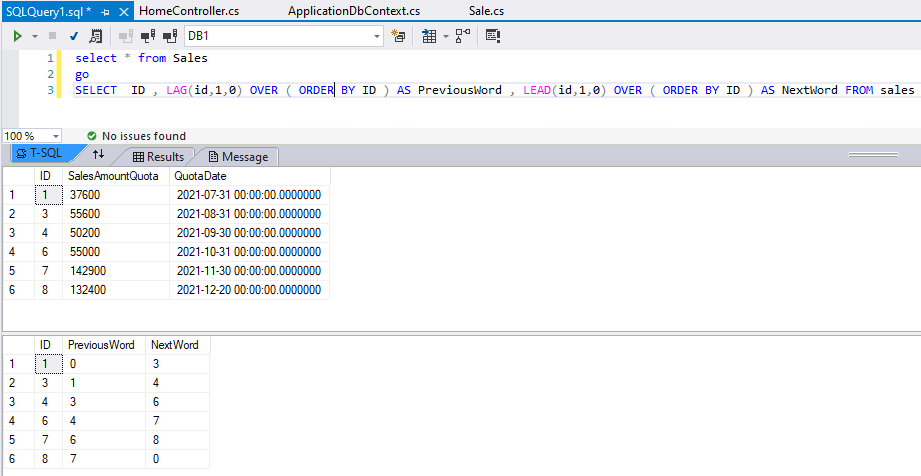Hi @Prathamesh Shende ,
Based on your SQL command, I create a table with the following data, and modify the SQL query command to set the default value when using the LAG and LEAD function:

Then, to using EF core get the same result, we could use the following code:
var result = _context.Sales.OrderBy(d => d.ID).Select(c => new
{
ID = c.ID,
PreviousId = _context.Sales.OrderBy(i => i.ID).Where(i => i.ID < c.ID).Select(i=>i.ID).LastOrDefault(),
NextId = _context.Sales.OrderBy(i => i.ID).Where(i => i.ID > c.ID).Select(i => i.ID).FirstOrDefault(),
}).ToList();
The Sale model:
public class Sale
{
[Key]
public int ID { get; set; }
public int SalesAmountQuota { get; set; }
public DateTime QuotaDate { get; set; }
}
Besides, we could also use the FromSqlRaw extension method to execute the SQL query command.
Based on the SQL query result to create a Model:
public class SaleViewModel
{
public int ID { get; set; }
public int PreviousWord { get; set; }
public int NextWord { get; set; }
}
Add to the ApplicationDbContext:
public class ApplicationDbContext: DbContext
{
public DbSet<Sale> Sales { get; set; }
public DbSet<SaleViewModel> SaleViewModels { get; set; }
Then, enable migration to generate the related table, after that, in the controller, use the following code to get the result:
var sqlresult = _context.SaleViewModels
.FromSqlRaw("SELECT ID ,LAG(ID,1,0) OVER ( ORDER BY ID ) AS PreviousWord , LEAD(ID,1,0) OVER ( ORDER BY ID ) AS NextWord FROM sales")
.Select(c=> new { ID = c.ID, PreviousID = c.PreviousWord, NextId = c.NextWord })
.ToList();
The result as below:

If the answer is helpful, please click "Accept Answer" and upvote it.
Note: Please follow the steps in our documentation to enable e-mail notifications if you want to receive the related email notification for this thread.
Best Regards,
Dillion

